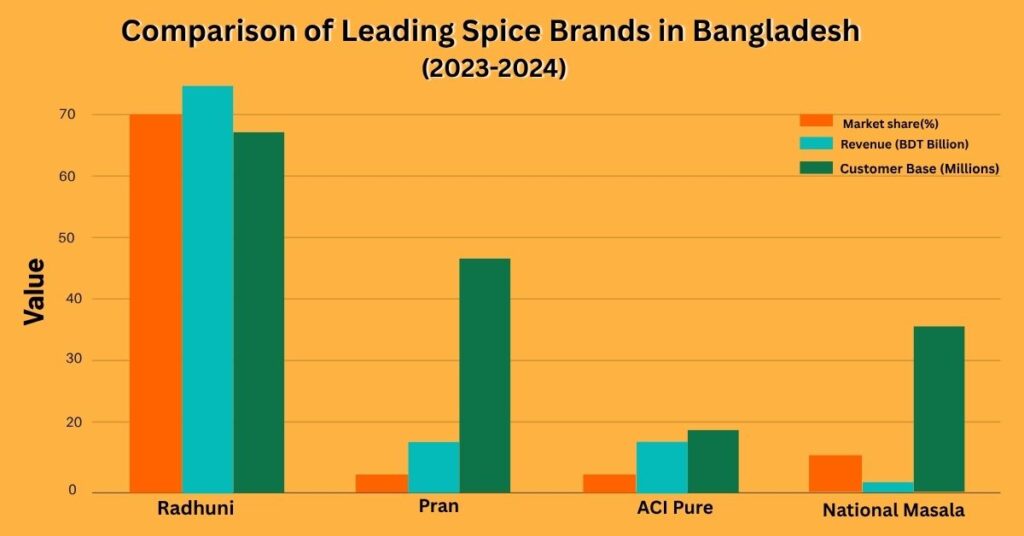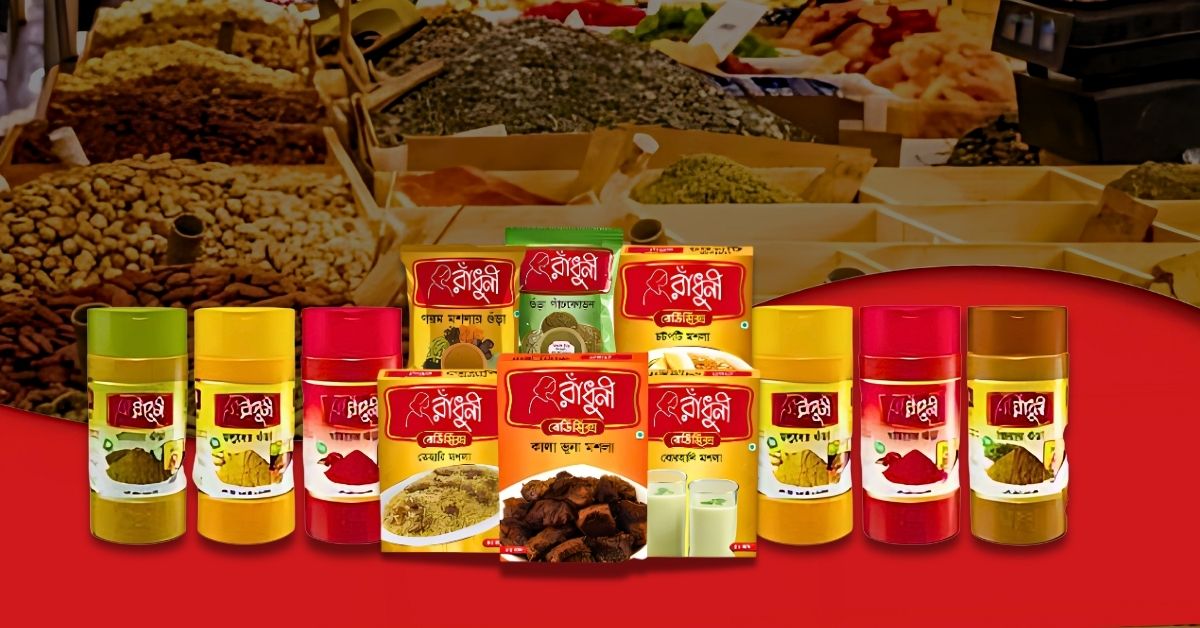1. Introduction:
In every corner of Bangladesh, from high-rise city apartments to rural village homes, the kitchen has always held a sacred place. It is where mothers teach daughters the secrets of spices, and grandmothers pass down recipes not found in any cookbook. For Bangladeshis, food is never just food; it is memory, emotion, and heritage served on a plate.
But as the world changed, so did our lives. Urbanization brought faster routines and smaller families. Women, once full-time homemakers, stepped confidently into the workforce. The time-consuming rituals of cleaning, drying, and grinding spices became harder to maintain, even though the craving for traditional flavors remained strong. People still wanted their mother’s curry, their grandmother’s bhuna, the warmth of home in every bite, but with less time and more pressure. It was in this very gap that Radhuni Masala was born.
2. History and Evolution of Radhuni Masala
Radhuni Masala started as a simple wish to bring back the taste of home in busy lives. Sooner, it became the bridge between tradition and today, keeping flavors close to our hearts.
2.1.The Cultural Gap in Modern Kitchens
The idea of Radhuni Masala was born out of a simple yet powerful insight: Bangladeshi households were looking for convenience without compromising on traditional taste. In the early 2000s, home cooks—especially working women and young families in urban areas—began seeking shortcuts in the kitchen due to time constraints. Yet, they didn’t want to lose the authenticity of age-old Bengali flavors passed down through generations.
2.2. A Vision Sparked at Square Group
Under the leadership of Square Group, guided by the vision of its founder, the late Samson H. Chowdhury and then Managing Director Tapan Chowdhury, identified this growing gap. They realized that there was a lack of hygienic, standardized, and ready-to-use spice blends in the local market. Most available spices were loose, manually ground, and lacked quality control. With a deep understanding of the Bangladeshi consumer psyche, they saw an opportunity to create something meaningful—a brand that could modernize the kitchen while preserving heritage.Tapan Chowdhury (Managing Director, Square Group) said:
“We didn’t want to just sell spices—we wanted to offer trust. Radhuni was created so that every home cook, from a busy office-going mother to a newlywed bride, could feel confident in their cooking.”
2.3. Leadership Steps That Made a Difference
The idea quickly moved from concept to strategy, for the efforts of key executives across Square. The CFO and finance department worked on the economic viability, while marketing leads like Md. Anisur Rahman focused on market research and consumer behavior. Together, they identified the potential in the packaged spice industry and committed to delivering standardized, hygienic, and flavor-consistent products.
2.4. The Birth of the Brand “Radhuni”
Square launched the Radhuni brand—aiming to bring “tradition with trust” into every kitchen. The name “Radhuni”—meaning “cook” in Bengali—was a deliberate and emotional choice. It symbolized gratitude toward the people behind every homemade meal. The brand was not just created to sell spices, but to honor the act of cooking itself, making it easier for everyone—from homemakers to professionals—to recreate traditional dishes. Md. Anisur Rahman (Marketing Executive, Early Brand Development Team) said :
“We chose the name ‘Radhuni’ because it meant more than a cook—it meant love, tradition, and patience. It was our way of honoring the ones who silently shape our families every day.”
2.5. Ownership Structure and Business Model
Radhuni is a 100% subsidiary of Square Food & Beverage Ltd, which in turn is a part of the Square Group, founded by the late industrialist Samson H. Chowdhury. There are no external joint venture partners or foreign equity holdings. The brand operates entirely under the corporate structure and financial support of Square Group.
Many consumer goods brands in Bangladesh rely heavily on third-party processing or outsourced packaging but Radhuni maintains full control over its procurement, production, quality assurance, R&D, and distribution processes. This vertically integrated model ensures consistency, supply chain efficiency, and high consumer trust. As of 2025
- Tapan Chowdhury – Managing Director and CEO of Square Group
- Parvez Saiful Islam – Chief Operating Officer (COO) of Square Group
- Md. Golam Kibria – Chief Financial Officer (CFO) of Square Group
2.6. Early Operations
The initial operations were modest but strategic. Radhuni started with a basic product line including ground turmeric, chili powder, coriander, and cumin, focusing on consistency in flavor and purity. The products were processed using automated grinding and packaging facilities to maintain quality and hygiene — a rarity in Bangladesh at the time.
SFBL capitalized on its strong distribution and marketing capabilities to quickly penetrate urban markets. Within two years, Radhuni established a foothold in major cities like Dhaka, Chittagong, Sylhet, and Rajshahi, gaining consumer trust. By 2005, the company began diversifying its offerings, moving into blended spice mixes and ready-to-cook traditional recipes, responding to the growing demand for convenience without compromising taste. This phase marked Radhuni’s transition from a basic spice producer to a household culinary brand.
3. Product Evolution and Portfolio
From its humble beginnings with a few basic spices, Radhuni has grown into one of the most trusted and diversified spice brands in Bangladesh. This journey of product evolution reflects not only business expansion but also a deep understanding of Bangladeshi culinary culture, seasonal needs, and emotional connections with food.
3.1. Basic Spices – The Foundation of Every Kitchen
Radhuni began by offering essential powdered spices such as turmeric (holud), red chili (morich), coriander (dhonia), and cumin (jeera). These masalas are the core of every Bengali kitchen, and Radhuni’s commitment for quality ensuring uniform grind, vibrant color, and rich aroma which helped it quickly gain consumer trust. These spices are available in multiple sizes, from small for individual to large family packs.
3.2. Blended Masalas – A Shortcut to Authentic Taste
Recognizing the growing demand for ready-made flavor solutions, Radhuni introduced blended masalas for specific dishes. Various blended masalas such as Beef Masala , Kabab Masala, Meat Curry Masala, Fish Curry Masala, Biryani Masala, Chicken Masala, and many more. Each blend is created using traditional recipes with carefully balanced proportions to match homemade flavour.bThat both novice cooks and busy families can achieve restaurant-quality taste with ease.
3.3. Ready Mixes – Traditional Desserts Made Easy
Among Radhuni’s unique products, Ready mixes for traditional Bengali sweets and recipes are one of them. In products such as Firni Mix, Payesh Mix, Falooda Mix, Chicken Fry Mix and Pulao Mix, Radhuni has made it extremely convenient for people to make exotic flavours and complex dishes in the comfort of a one’s own kitchen. These mixes save time, while retaining the genuine flavours that Bengalis relish. They’ve gotten particularly popular around festivals and family gatherings, when good food draws the whole family together.
3.4. Seasonal and Festive Specials
Radhuni is sensitive to the emotional role food plays at festivals. During the Eid-ul-Fitr and Eid-ul-Azha period, it introduces special items such as Shemai Mix, Payesh Mix and other celebratory ingredients. These offerings not only added extra happiness in celebration but build a deeper emotional connection between brand and consumer.
3.5. Snacks and Soups – Expanding Beyond Spices
In these changing lifestyles, Radhuni has also entered the instant food market with traditional snacks and instant soups. These serve the younger generation and city-dwellers who are in search of fast, delicious and reliable meal options..
Basically, Radhuni’s product portfolio is a thoughtful mix of tradition and convenience. It is crafted to suit the evolving needs of Bangladeshi households while preserving the rich heritage of Bengali cuisine.
4. Raw Material Sourcing and Quality Assurance
Behind every packet of Radhuni Masala lies a rigorous journey of sourcing, testing, and quality assurance—crafted with care to maintain the brand’s promise of purity, authenticity, and safety. Radhuni doesn’t just sell spices; it sells trust, built from the ground up—quite literally.
4.1. Direct Sourcing from Trusted Farmers
Radhuni believes that quality starts at the root. That’s why key raw materials such as chilies, turmeric, coriander, cumin, and fenugreek are sourced directly from local farmers across various agricultural zones in Bangladesh, including areas like Bogura, Rajshahi, and Jashore. This farm-to-factory model not only ensures freshness and traceability but also empowers rural communities through fair trade practices and long-term partnerships.
For certain exotic or high-volume ingredients, Radhuni imports select spices from international markets—particularly India, Myanmar, and Vietnam—where specific varieties thrive better. However, even imported raw materials must meet Square’s stringent procurement standards before they enter the production pipeline.
4.2. Uncompromising Quality Checks at Every Step
What truly sets Radhuni apart is its multi-layered quality control system, managed by Square Food & Beverage dedicated Quality Assurance (QA) and Research & Development (R&D) teams. Every batch of raw spice undergoes:
- Advanced laboratory testing to detect microbial activity, ensuring the spices are free from bacteria, mold, and other pathogens.
- Physical inspection and grading for color, aroma, and particle size.
- Metal detection systems on packaging lines to eliminate any chance of contamination during processing.
The company is certified with both HACCP (Hazard Analysis and Critical Control Points) and ISO 22000, two globally recognized food safety management standards. These certifications aren’t just for compliance—they reflect Square’s genuine commitment to delivering safe, clean, and superior-quality food products to millions of consumers.
4.3. Consumer Trust Through Consistency
This obsession with quality control isn’t just a technical requirement—it’s the reason Bangladeshi families continue to trust Radhuni. Whether it’s a mother cooking for her children, a student preparing a quick meal, or a restaurant relying on consistency—Radhuni ensures that every pinch of spice delivers the same flavor, safety, and satisfaction, every time.
In essence, Radhuni’s raw material sourcing and quality assurance are not just operational steps—they are the backbone of the brand’s reputation, rooted in integrity and care.
5. Radhuni Revenue Overview (2000–2025)
Radhuni, under Square Food & Beverage Ltd., has evolved from a small-scale spice brand to a household name in Bangladesh. Its consistent revenue growth reflects rising consumer trust, market expansion, and diversification of product categories.
5.1. Revenue Growth Journey
2000–2005: Foundation Phase
Radhuni was launched in the early 2000s with a small range of ground spices. Initial revenue was modest—estimated below BDT 10 crore annually—focused mainly on Dhaka and nearby regions. The brand emphasized quality and hygiene, distinguishing itself from loose and unbranded products.
2006–2010: Regional Expansion
By 2010, Radhuni’s reach expanded nationwide. Revenue reportedly crossed BDT 50 crore, fueled by growing demand for packaged masalas and an emerging middle-class preference for trusted brands.
2011–2015: Product Diversification
With the introduction of blended spices and ready-mixes, Radhuni’s revenue doubled, exceeding BDT 100 crore by 2015. Strong rural penetration and mass media campaigns contributed to market dominance.
2016–2020: Brand Maturity & Export Push
During this period, Radhuni expanded exports to over 30 countries. The domestic packaged spice industry reached BDT 1,000 crore, with Radhuni holding the largest share. Estimated revenue grew to over BDT 300 crore by 2020.
2021–2023: Pandemic Resilience and Instant Food Growth
Despite global disruptions, Radhuni grew steadily. Rising demand for convenient cooking and hygiene-conscious products helped sales. By 2023, the brand’s annual revenue crossed BDT 450 crore, including international sales.
2024–2025: Digital Expansion and Premiumization
In 2024, Radhuni leveraged digital marketing, introduced e-commerce-exclusive packs, and launched premium organic spice lines. Revenue is projected to reach BDT 520 crore in 2024, and BDT 580 crore by the end of 2025, driven by higher-margin products and increased rural market penetration.
5.2. Financial Performance
- 2015: Revenue milestone of BDT 100 crore, due to success of blended masalas.
- 2020: Estimated revenue exceeded BDT 300 crore, securing the top spot in the branded spice segment.
- 2023: Approx. BDT 450 crore in revenue, aided by ready-mix desserts, snacks, and international shipments.
- 2025 (Projected): Revenue to hit BDT 580 crore, supported by innovation in healthy and organic product lines.
5.3. Profitability and Projections
Radhuni has consistently remained profitable, benefiting from Square Group’s economies of scale and strong distribution.
- 2022: Operating profit margin ~15%, with estimated profits over BDT 60 crore.
- 2023: Margins improved with automation and exports; profit estimated at BDT 75 crore.
- 2025 (Forecast): Net profit expected to reach BDT 95 crore, driven by product innovation and global demand.
6. Challenges Faced by Radhuni and Strategic Solutions
From raw material volatility to consumer trust and market competition, Radhuni has encountered numerous hurdles throughout its journey. However, the brand’s strength lies in how it has strategically tackled each obstacle without compromising its core values of quality, tradition, and safety.
6.1. Supply Chain Disruptions During Eid Seasons
Challenge:
Eid-ul-Fitr and Eid-ul-Azha are periods of peak demand for Radhuni products. However, these coincide with transportation bottlenecks, labor shortages, and often delays in raw material sourcing from rural areas due to harvest cycles or road congestion.
Solution:
Radhuni’s logistics team has developed a pre-seasonal distribution model, where demand is forecasted months in advance, and stockpiles are built regionally. Strategic warehousing and AI-powered supply chain management tools ensure timely delivery even under pressure. Additionally, partnerships with third-party logistics (3PL) firms help the company scale delivery capacity during festivals.
6.2. Inflationary Pressures on Packaging and Logistics
Challenge:
Rising global costs of fuel, paper, plastic, and food-grade packaging materials have impacted production costs. Bangladesh’s domestic inflation has further strained transportation and warehouse operations.
Solution:
Radhuni is investing in sustainable, cost-effective packaging alternatives such as recyclable pouches and lightweight containers. The company has also begun using energy-efficient transportation methods and optimizing delivery routes to save fuel. Moreover, bulk procurement and long-term contracts with suppliers help lock in better rates.
6.3. Low-Quality Competitors
Challenge:
In Bangladesh’s open market, fake products and low-quality local brands often imitate Radhuni’s packaging and pricing. These products damage consumer trust and dilute brand value.
Solution:
Radhuni has implemented distinctive packaging, tamper-proof seals, and digital verification systems, such as QR codes for authenticity checks. Its brand team actively monitors markets, collaborates with law enforcement, and conducts awareness campaigns to educate consumers on how to identify genuine products.
6.4. Increasing Competition from Imported Masalas and Online Stores
Challenge:
The growth of cross-border e-commerce and rising popularity of imported Indian, Middle Eastern, and Pakistani spice blends have created new market pressures. Urban consumers are exposed to a wider variety of brands through online platforms.
Solution:
Radhuni is countering this by highlighting its authentic Bangladeshi flavor profiles, promoting national identity and nostalgia in its marketing. The brand has also expanded its own online presence, ensuring nationwide e-commerce delivery via platforms like Daraz, Chaldal, and its own website. Collaborations with food bloggers and chefs further reinforce brand relevance
6.5. Maintaining Flavor Consistency at Scale
Challenge:
As the demand for Radhuni grew nationally and internationally, maintaining consistent taste and aroma across millions of packets became increasingly difficult.
Solution:
Radhuni employs a dedicated R&D lab and flavor experts who monitor ingredient ratios, drying techniques, and grinding processes. State-of-the-art machinery and AI-supported batch tracking systems help maintain standardization, while frequent taste testing ensures no deviation from expected quality.
6.6. Adapting to Urbanization and Changing Lifestyles
Challenge:
As consumers—especially younger generations—shift toward ready-to-eat and fast food, traditional spice use has declined. Busy lifestyles also reduce time spent cooking elaborate meals.
Solution:
Radhuni expanded its portfolio with ready mixes, instant soups, and quick snacks, catering to urban needs without abandoning traditional flavors. Campaigns on platforms like YouTube and Facebook showcase easy recipes using Radhuni products, making traditional cooking relevant again.
6.7. Ensuring Hygiene and Safety During Crises (COVID-19)
Challenge:
During the COVID-19 pandemic, maintaining safe production and reassuring consumers about hygiene became a massive operational hurdle.
Solution:
Radhuni enforced strict health protocols, contactless production lines, and routine testing of staff. The brand increased communication about its HACCP and ISO certifications, using transparency to build public confidence during uncertain times.
Radhuni’s ability to anticipate, respond, and evolve in the face of challenges has helped it maintain its leadership in the Bangladeshi spice market. Instead of avoiding obstacles, the brand embraces them as opportunities to innovate, educate, and strengthen its bond with consumers—a hallmark of truly sustainable success.
7. Branding and Marketing Strategies of Radhuni
Radhuni’s campaigns reinforce trust, purity, and heritage—“converting open-spice users to hygienic packaged options” The brand maintains strong audience engagement via interactive initiatives:
- The popular cooking reality show “Shera Radhuni” has run for over 12 years, amplifying brand loyalty.
- International Market Promotion at Gulfood 2025 radhuni’s presence at the Dubai-based Gulfood expo reinforced its export ambitions. Branding focused on halal certification, premium quality, and global appeal.
- Radhuni Shundor Jibon” Social Media Campaign focused on highlighting everyday cooking moments and family stories using Radhuni. Leveraged Facebook, YouTube, and Instagram reels with influencer partnerships to boost engagement
- “Taste of Bangladesh” National Heritage Campaign Celebrated Bangladeshi culinary heritage by showcasing traditional dishes prepared with Radhuni. Collaborated with cultural figures and food historians to deepen emotional appeal.
- “Radhuni Festive Spice Packs” Launch Limited edition packs released for Eid and Pohela Boishakh with festive packaging and gift sets. Generated buzz and increased sales through exclusive retail promotions.
Branded ground spices market surpassed BDT 1,500 crore in 2024, growing at a double-digit annual pace, with Radhuni holding more than 70% market share . Radhuni’s ready-mix spice line expanded to over 30 SKUs by late 2024. These include mixes for biryani, curries, sweets (firni, falooda), and other dishes, driven by rising demand during rapid urbanization.This expansion aligns with lifestyle shifts—working women and younger consumers seeking quick, traditional-flavored meals—fueling category growth of 10–15% per year.
By early 2025, Radhuni was present at Gulfood 2025, showcasing its commitment to international markets and halal-compliant, hygienic standards . Square Food & Beverage exports to 36 countries, with Radhuni as a flagship export brand adhering to HACCP, Halal, ISO 9001, and FSSC 22000 certifications. Export growth of processed spices has been significant: from US $43.3 million (FY 2020–21) to consistent ~$42 million annual exports since.
Read More: How Qurbani Hides (2024-25) Boost Growth in Bangladesh’s Leather Industry
8. Comparison with Other Leading Spice Brands (Radhuni vs ACI Pure, Pran,National )
Radhuni is a leading spice brand in Bangladesh, but to understand its market position and competitive edge, it’s useful to compare it with other major players such as National, Priyojon, ACI Pure, and Pran.

8.1. Radhuni vs Pran:
- Launch and Operator:
- Radhuni was launched in 2000s by Square Food & Beverage Ltd, a subsidiary of Square Group, one of Bangladesh’s largest conglomerates.
- Pran is operated by Pran-RFL Group, a major FMCG player launched in 1981 (Pran brand developed over time).
- Market Position:
- Radhuni is the market leader in Bangladesh’s branded spice segment with about 70% market share (2024).
- Pran, a diversified FMCG brand, holds a significant presence in the spice category with around 5% market share, focusing on affordability and wide distribution.
- Customer Base:
- Radhuni products are used by millions of households nationwide, dominating urban and rural markets.
- Pran spices reach a wide customer base due to the group’s extensive distribution network and multiple product categories.
- Revenue & Growth:
- Square Food & Beverage (Radhuni’s parent) reported about BDT 115 billion in revenue in 2023, with Radhuni contributing significantly.
- Pran-RFL Group’s revenue is not publicly broken down by product category but the group’s total revenue was around BDT 600 billion in 2023, with FMCG as a major contributor.
- Pricing & Positioning:
- Radhuni is positioned as a mid to premium priced brand, emphasizing quality and innovation.
- Pran spices are generally lower priced, targeting mass-market affordability.
8.2. Radhuni vs ACI Pure:
- Launch and Operator:
- Radhuni launched in the early 2000s by Square Food & Beverage Ltd.
- ACI Pure, part of ACI Limited, one of Bangladesh’s largest conglomerates, has been operating since 1973, with the Pure brand focusing on premium spices.
- Radhuni launched in the early 2000s by Square Food & Beverage Ltd.
- Market Position:
- Radhuni leads with ~70% market share.
- ACI Pure holds around 5% market share, focusing on premium and hygiene-conscious consumers.
- Radhuni leads with ~70% market share.
- Customer Base:
- Radhuni’s customer base includes millions across both urban and rural Bangladesh.
- ACI Pure targets niche customers who prioritize quality and food safety certifications.
- Radhuni’s customer base includes millions across both urban and rural Bangladesh.
- Revenue & Growth:
- Square Food & Beverage Ltd (Radhuni) saw 19.45% revenue growth in 2023 with BDT 115 billion consolidated revenue.
- ACI Limited reported a 19.45% revenue increase in 2023, with BDT 115 billion in consolidated revenue, including FMCG, pharmaceuticals, and agribusiness.
- Square Food & Beverage Ltd (Radhuni) saw 19.45% revenue growth in 2023 with BDT 115 billion consolidated revenue.
- Pricing & Positioning:
- Radhuni offers a wide product range from basic to premium blends.
- ACI Pure is positioned as a premium-priced brand with emphasis on quality assurance and certifications like HACCP and ISO.
8.3. Radhuni vs National Masala
- Launch and Operator:
- Radhuni was launched in the early 2000s by Square Food & Beverage Ltd, a subsidiary of Square Group, one of Bangladesh’s largest conglomerates.
- National Masala is operated by National Food Limited, launched in 2004, specializing in spices and food products.
- Market Position:
- Radhuni is the market leader in the branded spice segment with around 70% market share nationwide (2024).
- National Masala holds a notable market presence, estimated at about 10-12% market share, focusing on affordability and accessibility.
- Customer Base:
- Radhuni has a massive customer base of millions of households across Bangladesh, especially popular in both urban and rural markets.
- National Masala also serves a large customer base, mainly in rural and semi-urban areas due to its competitive pricing.
- Revenue & Growth:
- Square Food & Beverage Ltd (Radhuni’s operator) reported revenue of approximately BDT 115 billion in 2023, with Radhuni being a key contributor.
- National Food Limited’s revenue is smaller but growing steadily, with estimated BDT 10–15 billion in 2023, focusing on expanding its product range and distribution network.
- Pricing & Positioning:
- Radhuni is positioned as a mid-to-premium priced brand emphasizing quality, variety, and food safety certifications (HACCP, ISO).
- National Masala is positioned as a budget-friendly brand targeting price-sensitive consumers, offering standard quality products at lower prices.
- Quality & Certifications:
- Radhuni follows strict quality assurance with advanced lab testing, metal detection, and international food safety certifications.
- National Masala maintains basic quality standards with efforts to improve hygiene and packaging but has fewer internationally recognized certifications.
9. Impact on Digital Economy
The rise of Radhuni and its digital evolution has had a profound impact on Bangladesh’s digital economy, especially in the fast-moving consumer goods (FMCG) and retail sectors. As one of the earliest spice brands to embrace digital transformation in branding, marketing, and distribution, Radhuni has contributed to several key areas of the country’s digital growth:
- E-Commerce Integration:
Radhuni products are now available across all major Bangladeshi e-commerce platforms including Daraz, Chaldal, Shwapno Online, and Evaly (before its collapse). This has helped normalize the practice of purchasing essential grocery items online among Bangladeshi consumers, especially during and after the COVID-19 pandemic. - Digital Payment Ecosystem:
By enabling cashless transactions through bKash, Nagad, Rocket, and other mobile financial services, Radhuni has supported the adoption of digital wallets in day-to-day purchases. As more people buy groceries online or from modern retail chains using digital payment methods, brands like Radhuni help increase transaction volumes across the digital financial infrastructure. - Supply Chain Digitization:
Square Food & Beverage Ltd has invested in ERP systems and automated inventory management, leading to better supply-demand forecasting, reduced wastage, and optimized logistics. This digitization ripple effect has influenced small distributors and local retailers to adopt tech-driven solutions for stock management and invoicing. - Digital Marketing and Branding:
Radhuni has leveraged YouTube, Facebook, Instagram, and influencer partnerships to drive brand engagement, cooking tutorials, and recipe content — creating a growing online food culture. Its marketing investments helped boost Bangladesh’s digital advertising sector, which is now valued at over BDT 1,000 crore as of 2025. - Foodtech and Startups:
The growth of trusted spice brands like Radhuni has indirectly benefited food delivery and recipe-based apps. Startups offering DIY cooking kits and grocery boxes often use Radhuni-branded spices to assure customers of quality — integrating traditional brands into the tech-enabled food supply chain. - Rural Digitization:
Radhuni’s wide distribution in rural areas has encouraged small shopkeepers and ‘mudir dokan’ owners to use smartphones for ordering products through digital B2B platforms (e.g., ShopUp, PriyoShop). This contributes to greater digital inclusion in rural commerce.
In summary, Radhuni’s scale, trust, and tech integration have helped bridge traditional retail with digital infrastructure, strengthening Bangladesh’s overall digital economy and setting a benchmark for other FMCG brands in the country.
10. Radhuni’s Spice Export Performance (2000–2025)

Spice Exports: Year-by-Year Highlights
- 2000–2010: Export activity was modest, averaging below US $15 million annually—ground and processed spices were small contributors in an export landscape dominated by raw agricultural commodities.
- 2011–2012: Marked a turning point with processed spice exports hitting US $13.6 million, signaling growth potential .
- 2020–2021: A landmark year as exports more than tripled to US $43.29 million, driven by rising global demand .
- 2022–2023 Fiscal Year: Export receipts consistently hovered around US $42–43 million, even as overall agri-exports fluctuated. Total spice exports reached US $42.38 million while imports were significantly larger at US $417.3 million .
- July–Sept 2023 (Q1 FY 2023–24): Exports increased by 25% YoY to US $11.25 million, compared to US $12.14 million in Q1 FY 2020–21 .
- July–Nov 2023: Bangladesh exported US $16.95 million worth of spices, with around 50% destined for Saudi Arabia.
- 2023–2024 Fiscal Year (July–June): Total agricultural product exports, including spices, rose 15.9% to US $965.2 million, with spices alone amounting to US $56.9 million, up 35.8% YoY .
- First Half FY 2024–25 (July–Dec 2024): Export earnings from agricultural products — including spices — crossed US $595.5 million, indicating a recovery toward the billion-dollar agri-export milestone
11. Future Outlook
Radhuni’s future trajectory appears both promising and strategically significant for Bangladesh’s FMCG industry and overall food security landscape. As consumer preferences evolve, technology disrupts traditional supply chains, and competition intensifies, Radhuni is poised to adapt, expand, and innovate across several dimensions:
1. Expansion into Ready-to-Eat and Frozen Categories
While Radhuni has traditionally focused on powdered spices, mixed masalas, and basic cooking essentials, Square Food & Beverage Ltd has been gradually entering the ready-to-eat (RTE) and ready-to-cook (RTC) segments. Given rising urbanization and dual-income households in Bangladesh, Radhuni is expected to expand its offerings in instant meals, frozen snacks, spice pastes, and semi-prepared items. This strategic shift could redefine convenience cooking in South Asia.
2. Export Market Strengthening
Radhuni already exports to over 25 countries, targeting Bangladeshi diaspora populations. However, with growing global interest in South Asian cuisine and Halal-certified products, the brand is likely to explore mainstream ethnic food aisles in Western supermarkets. Markets in the UK, Canada, Australia, and the Middle East could see increased Radhuni visibility, supported by partnerships with global distributors and e-commerce platforms like Amazon and Walmart Marketplace.
3. Digital Transformation and AI Integration
The next phase of Radhuni’s growth may involve smart supply chain management using AI and predictive analytics. From digital traceability of raw materials to AI-driven demand forecasting and personalized recipe suggestions via apps, Radhuni can integrate deeper technology to create a seamless food tech ecosystem. The brand may also explore smart packaging and QR-code based nutritional transparency to build further consumer trust.
4. Sustainability and Green Practices
With increasing global and local awareness around environmental issues, Radhuni is expected to adopt more sustainable practices — including biodegradable packaging, reduced carbon footprint in logistics, and responsible sourcing of agricultural inputs. Initiatives like partnering with eco-conscious farmers, launching zero-waste campaigns, or creating organic product lines could position Radhuni as a green pioneer in the South Asian spice industry.
5. Integration with Smart Kitchens and IoT
As Bangladeshi consumers begin adopting smart home technologies, Radhuni could explore partnerships with IoT-based kitchen device makers. Integration with voice assistants (like Google Assistant or Alexa) for cooking guidance or launching a proprietary smart cooking app featuring Radhuni spices and meal plans may align the brand with future consumer tech trends.
Radhuni is not just a spice brand but a cultural icon with the potential to become a full-fledged global food-tech player. Its future outlook rests on sustained innovation, strategic digitalization, export diversification, and continued commitment to quality — positioning it as a long-term leader in both domestic and international markets.
Read More: Microfinance Leads Bangladesh’s Fight Against Poverty
12. Lessons from Radhuni Masala
Over the years, Radhuni has grown beyond a brand. It has become a part of how millions of families cook, celebrate, and connect. But how did it manage to do this? What lessons can we take away from this spice giant’s journey?
12.1. Build Trust Through Consistency and Purity
Radhuni didn’t rise to the top overnight. Its position in the Bangladeshi market was earned over decades by being relentlessly consistent in quality. From its earliest days, the brand stood for purity—offering spices that mothers could trust, chefs could rely on, and families could enjoy safely. Unlike some competitors who focused on short-term volume, Radhuni knew that building trust is not a one-time act. It’s about doing the right thing every single time—no compromises, no shortcuts. This consistency in delivering authentic flavor and safety is what made Radhuni a staple in millions of kitchens.
12.2. Understand and Empathize With Your Core Customers
Radhuni wasn’t built on guesswork or assumptions. Its success came from deeply understanding the lifestyle, pain points, and aspirations of the average Bangladeshi household—especially homemakers. The brand recognized that modern life was becoming fast-paced, and traditional cooking methods often demanded time people no longer had. So it created spice blends and ready mixes that preserved tradition without requiring hours of labor. This empathy turned a product into a solution and a brand into a helping hand in daily life. Radhuni didn’t just sell spices—it offered peace of mind.
12.3. Innovate by Solving Everyday Problems
Innovation doesn’t always mean going digital or adopting cutting-edge tech. Sometimes, it means listening closely to what people need and simplifying their routines. Radhuni innovated by introducing pre-mixed spices, recipe packs, and even microwaveable items—bridging the gap between convenience and culinary tradition. Their product lines weren’t designed in isolation; they were crafted from everyday kitchen struggles. Whether it was a busy mother trying to cook biryani faster or a bachelor craving homemade flavors, Radhuni brought solutions that worked. That kind of innovation made them more than a spice company—it made them a partner in the kitchen.
12.4. Stay Authentic and Culturally Rooted
While many brands try to sound global and sleek, Radhuni found strength in staying close to its roots. It didn’t shy away from Bengali names, traditional recipes, or regional authenticity. The brand embraced the very essence of Bangladeshi cooking and built a bridge between past and present. This cultural grounding gave Radhuni not just customers—but loyalists. People didn’t just buy Radhuni because it was affordable or convenient—they bought it because it felt like home. In a world chasing trends, Radhuni stayed true to its identity—and that’s why it thrived.
12.5. Think Long Term, Not Just Profits
Radhuni’s journey teaches us that real success is not measured by quarterly profits, but by how long you stay relevant and respected. The brand didn’t try to grow overnight with flashy marketing or aggressive pricing. Instead, it focused on long-term value—investing in quality, brand loyalty, and cultural connection. This slow-burn strategy allowed it to build a brand that parents trust and children grow up with. In an era where many companies come and go, Radhuni’s lesson is clear: build a business that your next generation will be proud of, not just one that makes money fast.
Radhuni started in a country many overlook on the global map. It faced logistical problems, stiff competition, and limited export support. And yet—it grew, it thrived, and it inspired.The biggest lesson? Greatness can come from humble origins—if you dare to believe, stay grounded, and keep stirring the pot.
13. Conclusion
Radhuni is a part of our daily life, our kitchen stories, and our cultural identity. What started as a bold step by Square Food & Beverage Ltd. has now grown into something much bigger: a trusted name that we reach for without a second thought when cooking our favorite dishes. Whether it’s a simple daal or a festive biryani, Radhuni adds that perfect flavor we’ve come to rely on.
Over the years, Radhuni has done more than just dominate the market. It has set the benchmark for quality, hygiene, and innovation in Bangladesh’s food industry. From supporting local farmers and creating job opportunities—especially for women—to embracing digital platforms like online marketplaces and QR payments, Radhuni is evolving with the times. It’s not afraid to try new things, but it also never forgets its roots.
References
Share via:



















